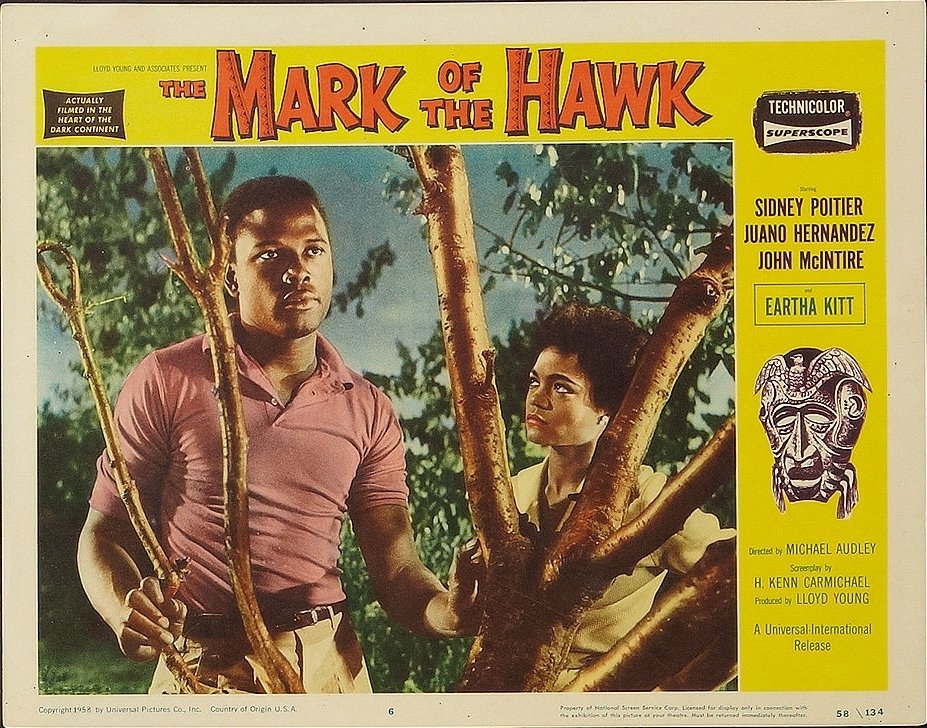The Mark of the Hawk is Forever
There are megastar Poitier films–In the Heat of the Night, Lilies of the Field, Porgy and Bess, even The Defiant Ones. I love them, but I think my favorite is the lesser known The Mark of the Hawk. Sidney Poitier stars alongside Eartha Kitt in a tense film about the struggle for independence in an African nation.
A less problematic promotional poster of The Mark of the Hawk
Poitier plays Obam who has returned from abroad, mobilizes the laborers, and becomes elected to a political post. He and his wife Renee, played by Eartha Kitt, seek the country’s independence through political means. However the country is already fractured–on one side, the frustrated Africans demanding independence and, on the other, the British occupiers who are fighting and clawing to retain their power. Obam, younger brother Kanda is part of a small, secret band of revolutionaries who are terrorizing the whites by hanging dead hawks outside their homes and later returning to burn the house and murder all the occupants. On the other extreme is Gregory, a newly arrived American, whose solution is to bring in the military, round up the savages, and teach them their place. They are, in his opinion, inferior and education has spoiled them. He uses spoiled as one speak about a child. Things are at a boiling point.
What makes this movie so compelling is that it was released in 1957, three years before Nigerian independence. Was it foreshadowing? The film does not shy away from the racial tensions of the moment–both in Africa and in America. The British officials are feigning ignorance about the source of the civil unrest, as if they hadn’t taken these people’s lands and then turned and hired them to work it. They excuse themselves because they “brought” Christianity and civilization to the continent, after all.
Christianity is supposed to be a balm for the Africans, the holy claim that all men are equal under God. But under man? Another story. As the unrest grows, the American does exactly what he does in the states. He creates a militia of a half dozen armed white men–all American. Baby, Gregory brought the Klan to Africa!
Now we see the true face of both the British and the American. What is Obam to do? He is already seen as suspicious, especially since Kanda is convinced that he will join him sooner or later and lead the revolution. Kanda believes this so blindly, he named the group Obam–the hawk. In the midst of the chaos, Obam tries to keep his faith, keep his purpose, and keep his head. He makes a heartfelt plea to the Parliament, simply asking for a timetable to independence, but is rebuffed with the flimsy claim that the Africans can “move freely.”
“Your excellency, is it not that my people want to merely to be treated freely or move freely. My people want to be free.”
As usual, justice and freedom are slowed by those who already have it. The ensuing bloodbath leaves Obam imprisoned unjustly and the country in disarray. Obam clings to his righteousness and, like his civil rights counterparts across the water, his faith.
On set filming The Mark of the Hawk
This couldn’t be a more timely movie; it is a snapshot of black bodies fighting in unison for freedom despite location. Prophetic? Perhaps not, but a beautifully imaginative explanation of the power struggles of the time. Obam muses late in the movie about a quote from Victor Hugo:
“There is one thing mightier than all the forces of the Earth, an idea whose time has come.”
We now watch the movie after all the injustices, the battles rarely won, and the slow progress. Still, the idea arrived and the mark of the hawk stays with us forever.
The symbol spray painted on the brick walls in The Mark of the Hawk.
The Mark of the Hawk is available streaming on Amazon Prime.



